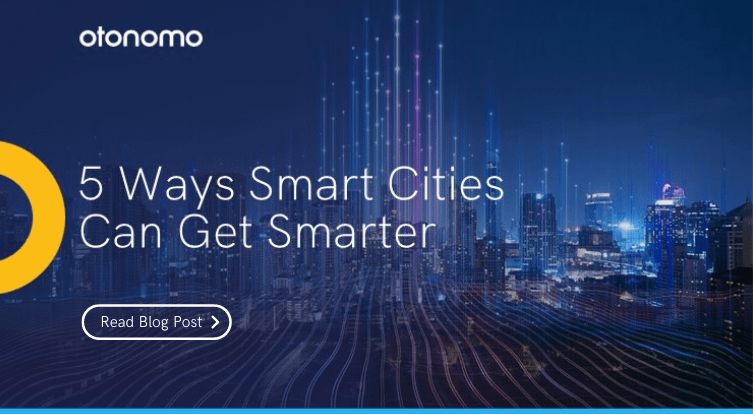Smart cities is a complex concept, covering a wide range of models and ideals that not everyone agrees on. However, in the context of the mobility economy, smart cities refers to cities that use technology and data to improve quality of life, leverage resources more efficiently, ensure the flow of traffic, and improve sustainability. It is an integrated approach seeking to optimize city systems by leveraging ground-truth data across urban and suburban spaces.
The move towards smarter cities has been with us for a while already, but here are five ways in which smart cities are getting increasingly smarter:
1. Add and measure micromobility and multimodality
In the past, cities found it extremely difficult to assess multimodal transportation. After all, counting bicycles is harder than counting cars. With no floating car data to support reporting, even smart cities found it difficult to understand the modal split within urban areas. But mass market uptake of electric, two-wheel, and micro-mobility devices – bikes and scooters – embraced by many cities as a means to reduce congestion and provide more sustainable mobility, is making understanding and measuring mobility across all means of transportation critical.
Tembici, Bird, and Lime – to name just a few of the companies in this space – all offer attractive last-mile alternatives that make ownership of a vehicle no longer an obstacle to adopt. Docked, non-electric bike sharing schemes, electric bikes, scooter sharing apps, and even shared electric motorcycles, all offer great convenience due to their ubiquitous availability and the fact that they do not require physical effort to operate.
Micromobility’s explosive success means that it must become an integral part of smart city planning, including facing pushback on where the vehicles are dropped off, safety issues for both riders and pedestrians, and profitability in the face of vandalism, regulations and deployment costs.
Cities that can assess mobility across all its facets – including micromobility – are not only smarter now, but also able to be smarter when planning for the future.
2. Use digital twins to simulate and research
Data in and of itself is a powerful tool in the hands of decision-makers, and for a long time, getting ground-truth multimodal mobility data was considered by many to be a crowning achievement. However, now that this is attainable, a new tool presents itself – holistic modeling of the entire city in the form of a digital twin.
Mobility data, processed using data science, machine learning and AI algorithms, is mapped onto a model of the city to provide a detailed digital environment that can be used to optimize operations in the present, explore and learn from incidents in the past, and run simulations to predict the future – making every smart city ready for new challenges.
3. Implement Integrated Road and Pavement Technology
Integrated road and pavement technologies are both novel and straightforward. The idea is simple – by embedding sensors into the road material, it can report back, supplying valuable data not only on the condition of the road and when it needs repairing, but also who is using it and how – with measures like traffic count, weights, and speed.
Taken further, roads can dynamically respond to conditions by, for example, changing the markings on them to create bus lanes as needed. Several companies are exploring making the roads electric and providing “charge as you drive” solutions for EVs, using buried wireless charging coils or induction loops.
We made our cars smarter, and we are making our cities smarter – time to make the streets smarter too.
4. Use mobility intelligence to make informed decisions based on more than one data source
Data is a challenge, even today, when data platforms are available to enable smart cities to access advanced data streams. Making sense of that data can be a daunting challenge. This is made even more preannounced when city planners, knowing better than to rely on only one data source, need to navigate different data sources and means of measurement.
More data sources mean more complexity, and more difficulty in surfacing meaningful insights from it. The solution to this problem lies in implementing mobility intelligence to the data. The fusing of rich data sources to understand multi-modal human movement, physical sources like mobile devices, municipalities, charging networks, micromobility performance, and more – are all used with machine learning and data science to create unique indicators that allow predictive real-world modeling.
Powering the ability to assess not only human movement, but also analyze real-world personas, context, intent, rider segmentation, preferences, and needs, then transforms large-scale data into actionable insights.
Mobility intelligence, by providing actionable insights – where once there were only mountains of data – together with sophisticated tools, allows smart city planners to focus on making decisions rather than on making sense of complex data sets.
5. Cooperate
One key element in making transportation services efficient, and a beneficial aspect of city life, is the ability to cooperate across technologies and organizations. Transport systems, be they IT or human-driven, need to work together across all levels to provide a better quality of service.
Cooperative systems like dynamic signage and traffic lights need to respond to what is happening in the city beyond mere vehicle traffic. Car sharing operators need to consider not only predictable times like end-of-day rush hour, but also, for example, if a train gets delayed or the weather is too cold for biking. Additionally, traffic can be rerouted to avoid a rowdy demonstration or heavy construction, miles out, before the city is gridlocked.
Want to learn more about using data and mobility intelligence to make your city smarter? Talk to one of our mobility experts today










